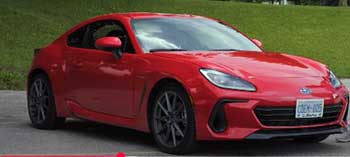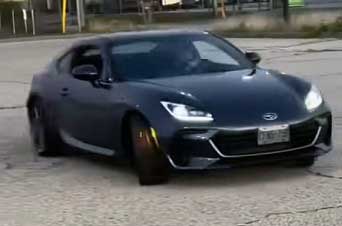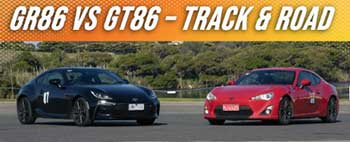
As a car enthusiast who’s spent countless hours behind the wheel, I’ve always been drawn to the thrill of affordable, rear-wheel-drive sports cars.
The Subaru BRZ and Toyota GT86 (or GR86 in its second generation) are twins born from a unique collaboration, yet they each have distinct personalities.
My goal in this article is to share my firsthand experience with both, exploring their key features, pros, cons, and maintenance needs in a conversational way.
Whether you’re a weekend cruiser or a track-day junkie, I’ll help you decide which of these coupes suits your driving passion.
Comparison Table
| Feature | Subaru BRZ | Toyota GT86/GR86 |
|---|---|---|
| Base Price (2023) | $28,595 | $27,900 |
| Engine | 2.4L 4-cylinder boxer, 228 hp, 184 lb-ft | 2.4L 4-cylinder boxer, 228 hp, 184 lb-ft |
| Transmission | 6-speed manual or automatic | 6-speed manual or automatic |
| 0-60 mph | 6.1 sec (manual), 6.6 sec (auto) | 6.2 sec (manual), 7.0 sec (auto) |
| Fuel Economy | 21 city/29 hwy (manual), 21/30 (auto) | 20 city/27 hwy (manual), 21/31 (auto) |
| Suspension Tuning | Firmer, track-focused | Softer, street-friendly |
| Interior Features | Cloth/Alcantara, 6.2” touchscreen (base) | Cloth/Alcantara, 7” touchscreen (base) |
| Safety Features | EyeSight (Limited trim), rearview camera | Adaptive headlights, rearview camera |
| Cargo Space | 6.3 cu ft | 6.2 cu ft |
| Warranty | 3 yr/36,000 mi, 5 yr/60,000 mi powertrain | 3 yr/36,000 mi, 5 yr/60,000 mi powertrain |
My Experience With The Subaru BRZ
When I first slid into the driver’s seat of the Subaru BRZ, I felt like I was stepping into a car built for someone who lives for the drive. The cockpit is driver-centric, with every control within easy reach. The low-slung seats hug you tightly, and the steering wheel feels like an extension of your hands.
On the road, the BRZ’s 2.4-liter boxer engine delivers a punchy 228 horsepower, a noticeable upgrade from the first generation’s 200 hp. Its sharp steering and firm suspension make it a dream on twisty backroads, where it feels planted and precise.
Taking the BRZ to a local autocross event was a revelation. The car’s balance is near-perfect, with a 53/47 front-to-rear weight distribution that lets you dance through corners with confidence. The limited-slip differential keeps the rear wheels in check, even when I pushed it hard. However, the firm ride can feel jarring on rough city streets, and the rear seats are more symbolic than functional—best for your gym bag, not passengers.
The infotainment system, while functional, feels a bit dated with its small 6.2-inch screen on the base model. Still, the BRZ’s raw driving experience is hard to beat for the price.
The BRZ’s styling is understated but purposeful. Its sleek lines and low hood scream sports car without being overly flashy. The tS trim, with its Brembo brakes and STI-tuned suspension, elevates the experience for track enthusiasts like me.
Maintenance is straightforward, but I learned quickly that premium fuel is a must to keep the engine happy. After months of driving, the BRZ feels like a loyal companion that rewards skill and precision, though it demands your full attention on the road.
Pros Of The Subaru BRZ

- Sharp Handling: The BRZ’s suspension tuning and low center of gravity make it a corner-carving machine, ideal for track days or spirited drives.
- Driver-Focused Cockpit: The interior is designed with the driver in mind, with supportive seats and intuitive controls that enhance the driving experience.
- Fuel Efficiency: With 21 mpg city and 29 mpg highway (manual), it’s surprisingly economical for a sports car, saving me at the pump.
- Affordable Performance: Starting at $28,595, it delivers thrills without breaking the bank, perfect for enthusiasts on a budget.
- Safety Features: The Limited trim’s EyeSight system, including lane-keep assist and adaptive cruise, adds peace of mind for daily driving.
- Subaru Reliability: The BRZ benefits from Subaru’s reputation for durability, with fewer maintenance headaches than some competitors.
- Customization Potential: Aftermarket support is strong, letting you tweak suspension, exhaust, or aesthetics to suit your style.
The BRZ’s handling is its biggest selling point. I took it through a mountain pass, and the way it hugged corners felt almost telepathic. The steering is razor-sharp, giving me confidence to push harder with each turn. The fuel economy surprised me—I averaged 27 mpg on a long road trip, which is impressive for a car this fun.
Subaru’s EyeSight system, available on higher trims, made highway driving less stressful, especially in traffic. The aftermarket community is a goldmine; I added a cold-air intake for a slight power boost and better engine sound. Overall, the BRZ feels like a pure driver’s car, built for those who prioritize control and engagement over raw power.
Read more: My Thoughts on GMC Terrain Vs. Ford Escape
Cons Of The Subaru BRZ
- Firm Ride: The stiff suspension makes daily commutes on rough roads feel punishing, especially over potholes.
- Limited Rear Space: The 2+2 layout is cramped; rear seats are better for storage than passengers, even for kids.
- Basic Infotainment: The 6.2-inch touchscreen feels small and outdated, lacking Apple CarPlay or Android Auto in base models.
- Engine Torque: While the 2.4L engine is peppy, it lacks low-end torque, making city driving feel sluggish at times.
- Cabin Noise: Road and engine noise are prominent, which can be tiring on long drives without good soundproofing.
- Base Trim Sparsity: The Premium trim lacks some creature comforts, like heated seats, unless you upgrade to Limited.
- Manual Transmission Learning: The 6-speed manual can feel notchy for new drivers, requiring practice for smooth shifts.
The BRZ’s firm ride was a double-edged sword. While great for handling, it made my daily commute over bumpy city streets less enjoyable. The rear seats are practically useless—I tried fitting a friend back there, and they were uncomfortable within minutes. The infotainment system frustrated me with its small screen and lack of smartphone integration, which feels like a miss in 2025.
In stop-and-go traffic, the engine’s lack of low-end grunt meant I had to rev it higher to get moving, which got old fast. Cabin noise was another issue; long highway drives left my ears ringing without a good playlist to drown it out. Still, these are trade-offs for a car this focused on driving purity.
Maintenance Tips For The Subaru BRZ
- Use Premium Fuel: The 2.4L boxer engine requires 91-octane or higher to maintain performance and avoid knocking.
- Regular Oil Changes: Change synthetic oil every 6,000 miles or 6 months to keep the engine running smoothly.
- Tire Maintenance: Rotate tires every 5,000 miles and check alignment regularly, especially after track days, to prevent uneven wear.
- Brake Inspections: Check brake pads every 10,000 miles, particularly if you drive aggressively, as they wear quickly.
- Cooling System Care: Flush the coolant every 30,000 miles to prevent overheating, critical for the boxer engine’s health.
- Suspension Checks: Inspect shocks and struts annually for leaks or wear, especially with the BRZ’s firm setup.
- Clean Air Filters: Replace cabin and engine air filters every 15,000 miles for optimal performance and air quality.
Maintaining the BRZ is straightforward but requires diligence. I learned early that using anything less than premium fuel made the engine feel sluggish and caused slight pinging. Oil changes are non-negotiable; I stick to synthetic 5W-30 and change it every 6,000 miles to keep the boxer engine happy. Tires take a beating on this car, especially if you’re carving corners regularly.
So I rotate them religiously and check alignment after every track session. Brake pads wear out faster if you’re pushing the car, so I inspect them often. The cooling system needs attention too—overheating is a risk if you skip coolant flushes. Keeping air filters fresh ensures the engine breathes well, and I noticed a slight power dip when I neglected this once. These steps keep the BRZ in top shape for years of fun.
My Experience With The Toyota GT86/GR86
The Toyota GT86 (now GR86 in its second generation) feels like the BRZ’s slightly more extroverted sibling. Sliding into the GR86, I noticed its sporty yet slightly softer vibe compared to the BRZ. The seats are just as supportive, but the interior has a touch more flair with contrast stitching and a 7-inch touchscreen on the base model.
The 2.4-liter boxer engine, identical to the BRZ’s, delivers the same 228 horsepower, but the GR86’s suspension tuning leans toward street comfort over track precision. It’s a blast to drive, with a tail-happy nature that makes drifting easier for less experienced drivers.
On a winding coastal road, the GR86 felt playful, with a rear end that slides predictably when provoked. Its 0-60 mph time of 6.2 seconds (manual) is a hair slower than the BRZ, but I barely noticed in real-world driving.
The cabin is slightly quieter than the BRZ’s, making it a better daily driver. However, like the BRZ, the rear seats are more for show, and the base infotainment lacks modern smartphone integration. The GR86’s aggressive front bumper and optional TRD accessories give it a bolder look, which turned heads wherever I parked.
The GR86’s Trueno Edition, with its two-tone paint and Sachs dampers, added extra flair during my test drive. It’s slightly lighter at 2,811 pounds compared to the BRZ’s 2,815, which I felt in its nimble handling.
Maintenance is nearly identical to the BRZ, but Toyota’s dealer network feels more accessible for service. The GR86 strikes a balance between fun and practicality, making it a great choice for someone who wants a sports car they can live with daily.
Pros Of The Toyota GT86/GR86

- Playful Handling: The GR86’s softer suspension makes it more tail-happy, perfect for fun drives or learning to drift.
- Bold Styling: Its aggressive front bumper and optional TRD accessories give it a sportier, head-turning look.
- Slightly Lower Price: Starting at $27,900, it’s a touch cheaper than the BRZ, offering great value.
- Comfortable Ride: The softer suspension smooths out rough roads, making it a better daily driver than the BRZ.
- Toyota Reliability: Toyota’s reputation for bulletproof engines means fewer worries about long-term maintenance.
- Larger Touchscreen: The 7-inch touchscreen in the base model feels more modern than the BRZ’s 6.2-inch unit.
- Exclusive Features: The GR86 offers a one-year NASA membership and a high-performance driving experience in the U.S.
The GR86’s playful nature won me over during a spirited drive through a canyon. Its willingness to slide made every corner a thrill, and I felt in control even when pushing the limits. The styling, especially the Trueno Edition’s two-tone look, drew compliments at every stop.
The slightly lower starting price saved me a few bucks, and the smoother ride was a godsend on my city’s pothole-ridden streets. Toyota’s reliability gave me confidence for long-term ownership, and the larger touchscreen was a small but noticeable upgrade. The NASA membership is a cool perk—I’m already planning to redeem it for a track day. The GR86 feels like a sports car with a bit more personality.
Cons Of The Toyota GT86/GR86
- Less Precise Handling: The softer suspension sacrifices some track precision compared to the BRZ’s sharper setup.
- Cramped Rear Seats: Like the BRZ, the 2+2 layout is impractical for passengers, better suited for cargo.
- Noisy Cabin: While quieter than the BRZ, road noise is still noticeable, especially on long highway drives.
- Base Infotainment Limits: No Apple CarPlay or Android Auto in the base trim feels like a missed opportunity.
- Slightly Slower: The 0-60 mph time of 6.2 seconds (manual) is a fraction slower than the BRZ’s 6.1 seconds.
- Limited Safety Features: Lacks the BRZ’s EyeSight system; adaptive headlights are the main safety highlight.
- Manual Transmission Feel: The 6-speed manual can feel vague, requiring extra focus for smooth shifts.
The GR86’s softer suspension made it less composed than the BRZ during aggressive cornering, which I noticed on a tight autocross course. The rear seats were as useless as the BRZ’s—I tried using them for groceries, but folding them down was easier. Road noise crept in on long drives, though it was less intrusive than in the BRZ.
The lack of Apple CarPlay in the base model annoyed me when I wanted to stream music seamlessly. The slightly slower acceleration wasn’t a dealbreaker, but I felt it in stop-and-go traffic. The manual gearbox took some getting used to, with occasional notchy shifts that disrupted my flow. Still, the GR86’s charm lies in its accessibility and fun factor.
Maintenance Tips For The Toyota GT86/GR86
- Premium Fuel Only: Use 91-octane or higher to ensure the 2.4L engine performs optimally and avoids knocking.
- Oil Changes: Switch synthetic oil every 6,000 miles or 6 months to maintain engine health and performance.
- Tire Rotation: Rotate tires every 5,000 miles and check alignment, especially after spirited drives, to avoid wear.
- Brake Maintenance: Inspect brake pads every 10,000 miles, as aggressive driving can wear them out quickly.
- Coolant Flushes: Flush the cooling system every 30,000 miles to prevent overheating in the boxer engine.
- Suspension Checks: Annually inspect shocks and struts for wear, given the GR86’s softer, street-tuned setup.
- Air Filter Replacement: Replace engine and cabin air filters every 15,000 miles for better efficiency and air quality.
Maintaining the GR86 is nearly identical to the BRZ, but I found Toyota dealers more convenient for scheduling service. Premium fuel is a must—I noticed a slight power dip when I accidentally used regular once. Oil changes every 6,000 miles kept the engine purring, and I stuck to synthetic 5W-30 for consistency.
Tires wear faster with the GR86’s tail-happy nature, so I rotate them diligently and check alignment after every canyon run. Brake pads need regular checks, especially if you’re sliding the car often. Coolant flushes are critical to avoid engine issues, and fresh air filters keep the cabin comfortable and the engine responsive. These steps ensure the GR86 stays ready for any adventure.
Comparison With Other Brands
- Mazda MX-5 Miata: The Miata’s 181 hp 2.0L engine is less powerful, but its lighter 2,400-pound curb weight makes it feel nimble; it’s more cramped but offers a convertible top for open-air fun.
- Nissan 370Z: With a 332 hp V6, the 370Z is faster but heavier and thirstier, with 18 mpg city; its dated interior and higher price ($39,000) make it less practical.
- Ford Mustang EcoBoost: The Mustang’s 310 hp turbo four-cylinder offers more power, but its 3,400-pound weight dulls handling; it’s pricier at $32,000 but roomier.
- BMW 2 Series Coupe: Starting at $38,000, the 2 Series has a refined 255 hp turbo engine but lacks the BRZ/GR86’s raw, analog feel; it’s more luxurious but less engaging.
- Audi TT: The TT’s 228 hp turbo four matches the twins’ power, but its $50,000 price and all-wheel-drive setup prioritize comfort over sportiness.
- Honda Civic Si: At $28,000, the Civic Si’s 200 hp turbo engine and front-wheel-drive layout offer practicality but lack the rear-drive thrill of the BRZ/GR86.
- Chevrolet Camaro: The Camaro’s 275 hp V6 is potent, but its $30,000 base price and heavier chassis make it less agile than the BRZ or GR86.
The Mazda MX-5 Miata is a close rival, with its featherlight chassis making it a joy on tight roads, but its smaller cabin and lower power output can’t match the twins’ versatility. The Nissan 370Z feels like a muscle car in comparison, with brute force but less finesse and worse fuel economy. The Ford Mustang EcoBoost has power in spades, but its heft dulls the experience on twisty roads.
The BMW 2 Series leans toward luxury, missing the raw edge I love in the BRZ and GR86. The Audi TT is too polished and pricey, while the Honda Civic Si trades rear-drive fun for practicality. The Camaro’s power is tempting, but its weight and cost tip the scales toward the Subaru and Toyota for pure driving joy.
Also read: My Thoughts on Ford Edge Vs. Hyundai Tucson
Frequently Asked Questions (FAQ)
The BRZ edges out slightly for track-focused driving due to its firmer suspension, while the GT86 (GR86) is better for daily comfort with its softer ride. It depends on your priorities—track precision or street fun.
The GR86 is more playful and slightly cheaper, ideal for street driving and drifting. The BRZ’s sharper handling suits track enthusiasts. Choose based on whether you want fun or precision.
The 2023 BRZ starts at $28,595, while the GR86 starts at $27,900, giving the GR86 a slight price advantage. Higher trims like the BRZ tS ($36,465) cost more than the GR86 Trueno Edition ($34,360).
They’re nearly identical, sharing the same platform, engine, and most components. Differences lie in suspension tuning, styling, and minor interior features. The BRZ is track-focused; the GR86 is street-oriented.
Conclusion: For Subaru BRZ And Toyota GT86/GR86
You can’t go wrong with either the Subaru BRZ or Toyota GT86/GR86—both are thrilling, affordable sports cars that put driving joy first. If you crave razor-sharp handling and track-day precision, the BRZ’s firmer setup will make your heart race.
If you want a playful, street-friendly ride with a bolder look, the GR86 is your match. I’ve loved driving both, and their shared DNA ensures you’re getting a pure sports car experience. Pick the one that speaks to your driving style, and you’ll be grinning every time you turn the key.

